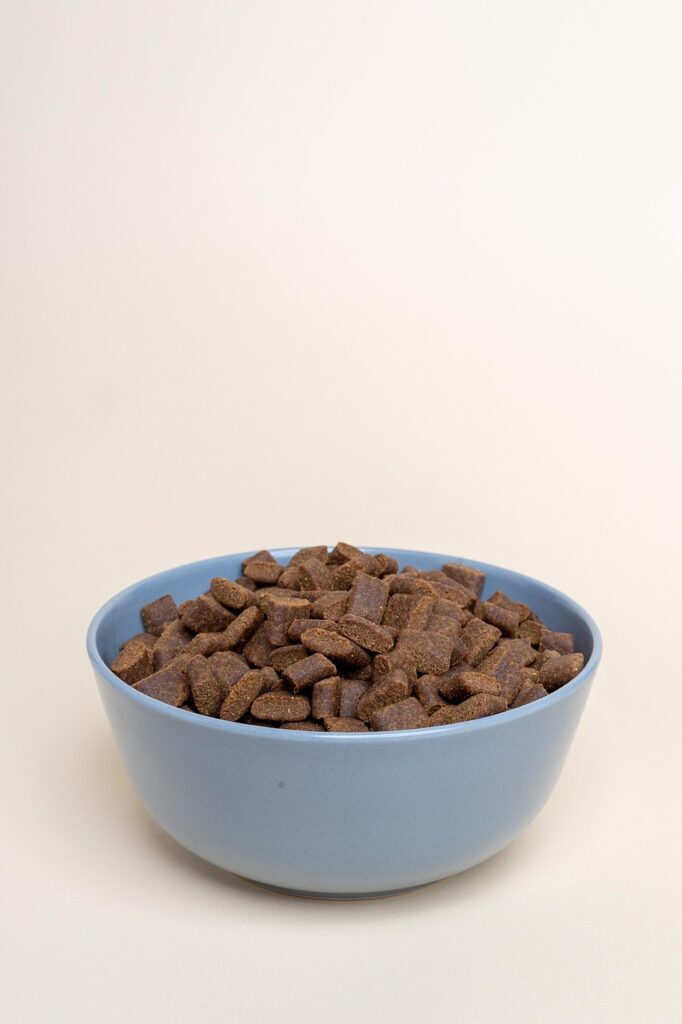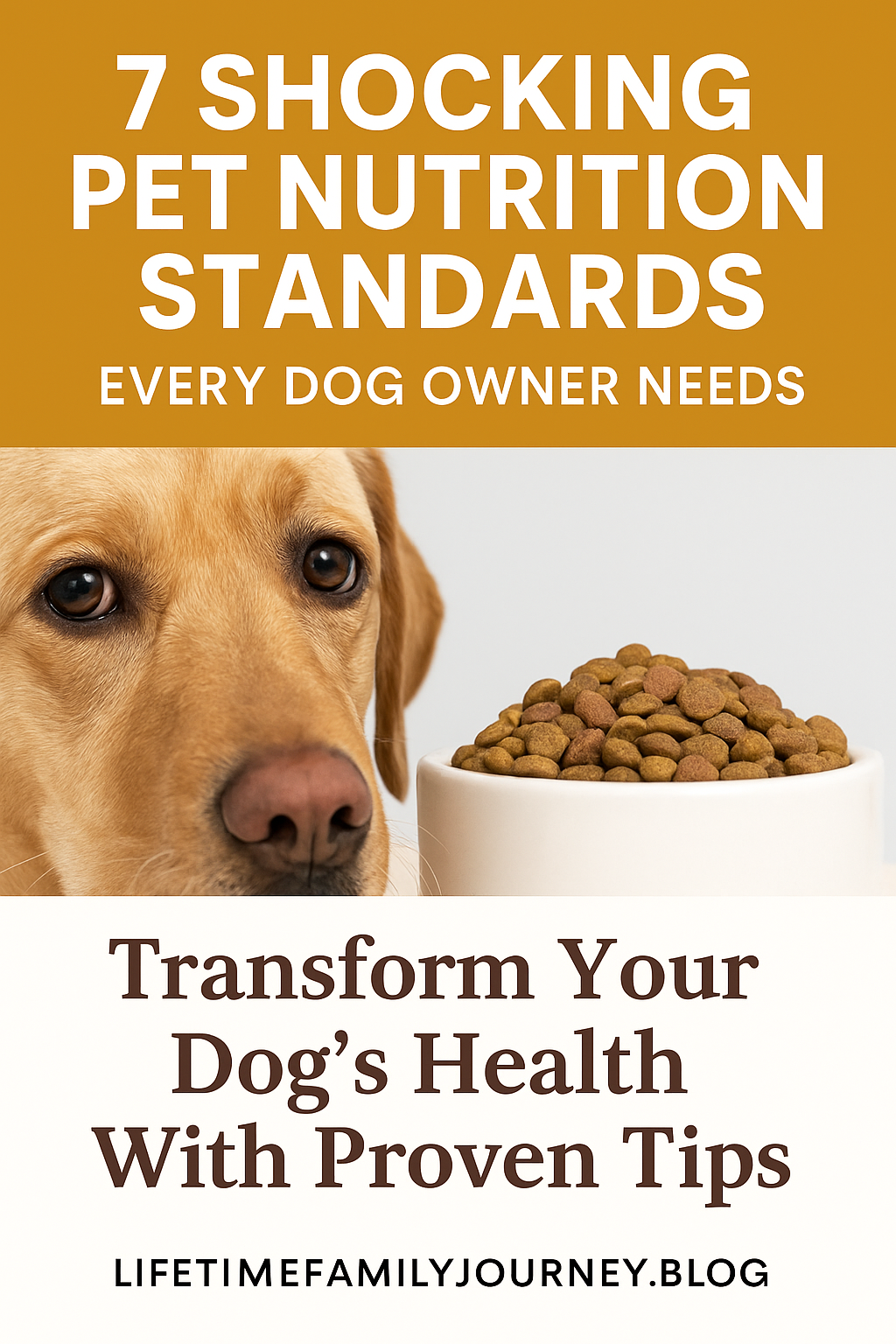7 Shocking Pet Nutrition Standards Every Dog Owner Needs
Ever wondered why some dogs thrive while others constantly battle health issues? As a father of six who’s also responsible for our family’s furry members, I’ve learned that what goes in their bowl dramatically impacts their quality of life. 🐶

Not everyone will agree to what is healthy and what is not when it comes to their pets. Some will believe one brand is better than the other, even if the same ingredients are in it. In fact, the myth that is still perpetuated about veterinarians getting commissions on specific office-carried brands is still moving around social media platforms. I did say myth, correct? So, what do our pets need? Even better, what do WE need?
The Hidden Connection Between Human and Pet Nutrition Standards 🔍
Constant research is being done regarding health, wellness, and dietary needs for us. This constant development requires updating and delivery to the general public, which is done every 5 years. The U.S Department of Agriculture and The Health and Human Services makes this update to the dietary guidelines and can be seen at www.dietaryguidelines.gov. There’s a whole slew of information in this guide to digest from the best vegetables to put on your plate to specific guidelines for lactating women, but nutritional details you’re used to seeing for dogs and cats to compare is this:

 Daily HOOMAN Nutritional Profile
Daily HOOMAN Nutritional ProfileI’m almost willing to guarantee that most of us haven’t taken a look down this. BUT, many pet owners have begun to look at this profile for their pets. Why the disconnect? Shouldn’t we care for ourselves as well? The truth is that there are organizations in charge of making sure companies put that label on there, just the same as the pet industry. They just go one step further. If you choose one that meets specific criteria, you personally can ensure higher standards are met. This isn’t because that’s typically is what’s at your vets office. It’s because that’s the veterinarian standard. I’m talking about AAFCO, the Association of American Feed Control Officials.
Understanding AAFCO Guidelines: The Gold Standard in Pet Nutrition ⭐
AAFCO’s Mission: AAFCO is a collaborative association that supports members and stakeholders and promotes a safe feed supply through unified system-based regulation, feed ingredients standards, and laboratory operations. – www.aafco.org
This agency is not in charge of regulating (that’s the FDA) or testing food, but they do have a tremendous impact on ensuring states and members have universal guidelines and standards. This includes protecting us by not allowing companies to state “nutritionally complete” unless they meet specific guidelines. Their guideline is posted here: AAFCO Pet Food Report But, if you’re super not sure what to look for, follow this: WSAVA Global Nutrition Toolkit
The AAFCO guidelines represent more than just bureaucratic hoops for manufacturers to jump through. They establish essential pet nutrition standards that directly impact your dog’s health, energy levels, and longevity. When you see that AAFCO statement on your dog food package, it means the formula has met minimum requirements for protein, fat, vitamins, and minerals specific to your pet’s life stage.
The Real-World Impact of Pet Food Selection: Our Family’s Story 🏡
Either way you look at it or what brand you purchase, your pet will be affected. We have 2 Australian Shepherds who are notorious for being finicky. We made a choice to use the Kirkland brand dog food, after them previously being on Purina One Pro Plan, within a week they turned to this…

They were uncomfortable, itchy, and miserable. They also had more patches of fur laying across the downstairs (more vacuuming). Needless to say, we’re going back to the Purina One Pro Plan.
This experience wasn’t unique to our household. Many families discover that bargain hunting for pet food often leads to unexpected health consequences. While I’m not suggesting everyone needs to purchase the most expensive brand on the market, understanding pet nutrition standards helps you make informed decisions about where to invest and where to save.
7 Critical Pet Nutrition Standards Every Responsible Dog Owner Should Know 🔑
Let’s dive deeper into what makes certain dog foods superior to others, regardless of marketing claims or attractive packaging. These pet nutrition standards can make the difference between a thriving pet and one constantly visiting the vet.
1. Protein Quality Matters More Than Quantity 🥩
When examining pet nutrition standards, the source and quality of protein tops the list of importance. Many budget brands list “meat” or “poultry by-product meal” as primary ingredients. These vague terms can include low-quality protein sources that are difficult for your dog to digest and utilize effectively.
High-quality dog foods specify the exact protein source—chicken, beef, lamb, etc.—and ideally list a whole protein source rather than a meal or by-product as the first ingredient. This transparency indicates better pet nutrition standards and typically results in better digestibility and nutrient absorption.
My Aussies struggled with the switch to a food that technically had similar protein percentages but used different protein sources. Their bodies simply couldn’t process it efficiently, leading to those uncomfortable skin issues and excessive shedding.

2. The Truth About Grains in Dog Food 🌾
The grain-free trend exploded in pet food marketing several years ago, convincing many dog owners that grains were harmful fillers. However, recent research and AAFCO guidelines suggest otherwise. Unless your dog has a specific grain allergy (which is actually quite rare), whole grains can provide valuable nutrients and fiber.
In fact, the FDA has investigated a potential link between grain-free diets and dilated cardiomyopathy (DCM) in dogs. This doesn’t mean all grain-free foods are problematic, but it does highlight the importance of following established pet nutrition standards rather than marketing trends.
When we selected our dogs’ food, we specifically chose one that included whole grains like brown rice and barley rather than using peas, lentils, or potatoes as the primary carbohydrate sources. This aligns with current nutritional understanding and AAFCO guidelines for balanced dog nutrition.

3. The Guaranteed Analysis: Reading Between the Lines 📊
Every dog food package includes a guaranteed analysis section that lists minimum percentages of protein and fat along with maximum percentages of fiber and moisture. Understanding how to interpret these numbers is crucial to evaluating pet nutrition standards.
However, these percentages don’t tell the complete story. Two foods might both list 26% protein, but the digestibility and biological value of that protein can differ dramatically. This explains why my dogs reacted poorly to the budget brand despite similar guaranteed analysis numbers.
AAFCO guidelines require these measurements, but savvy pet owners go beyond percentages to research the quality of ingredients and the manufacturer’s testing protocols. More transparent companies will provide digestibility information or the results of feeding trials, which are stronger indicators of food quality than percentages alone.
4. Life Stage-Appropriate Nutrition: Not Just Marketing 🐶→🦮
One of the most important pet nutrition standards involves matching your dog’s food to their life stage. Puppies, adult dogs, and seniors have significantly different nutritional requirements. AAFCO guidelines establish specific nutrient profiles for growth (puppies), maintenance (adults), and all life stages.
Foods labeled for “all life stages” must meet the more demanding nutritional requirements for growth and reproduction. While this might seem like a convenient one-size-fits-all solution, it often means puppies get appropriate nutrition while adult dogs receive excessive calories and nutrients they don’t need.
Our Aussies are both adults, so we specifically chose an adult formula that meets AAFCO adult maintenance requirements rather than an all-life-stages formula. This helps prevent unnecessary weight gain while ensuring they get exactly what they need.

5. The Supplement Trap: When More Isn’t Better 💊
Many pet food companies tout added supplements like glucosamine, chondroitin, or omega fatty acids as selling points. While these can be beneficial, they often appear in amounts too small to provide therapeutic benefits. True pet nutrition standards focus on complete and balanced nutrition from quality ingredients rather than minimal sprinklings of trendy supplements.
If your dog genuinely needs joint support, skin health improvement, or other targeted nutrition, it’s usually more effective to provide a high-quality base diet that meets AAFCO guidelines and then add specific supplements at therapeutic dosages under veterinary guidance.
We found that the excessive additives in some foods actually contributed to our dogs’ sensitivities. Sometimes simpler formulations with fewer ingredients but higher quality standards yield better results.
6. Manufacturing Standards: The Hidden Factor in Pet Food Quality 🏭
AAFCO guidelines address nutrient content, but equally important are the manufacturing practices used to produce the food. Companies that own their manufacturing facilities (rather than outsourcing production) typically maintain stricter quality control over the entire process.
Questions worth asking about any pet food company include:
- Do they conduct regular safety testing?
- Have they ever had a recall, and if so, how was it handled?
- Do they test finished products or just ingredients?
- Where do they source their ingredients?
The Purina Pro Plan we returned to is produced in company-owned facilities with multiple quality checks throughout the manufacturing process. This attention to production standards likely contributes to why it works better for our sensitive Aussies.

7. The Feeding Trial Gold Standard 🏆
While many foods meet AAFCO guidelines through formulation (nutrient analysis on paper), the gold standard in pet nutrition involves actual feeding trials. These trials require the food to be fed to real dogs for a specific period while monitoring various health markers.
Foods that have undergone AAFCO feeding trials typically include a statement like: “Animal feeding tests using AAFCO procedures substantiate that [Product Name] provides complete and balanced nutrition.” This represents a higher standard than formulation alone.
When researching pet nutrition standards for our dogs, I specifically sought out brands that conduct feeding trials rather than relying solely on nutritional analysis. The proof, after all, is in how dogs actually thrive on the food—not just in laboratory measurements.
Decoding Pet Food Labels: Beyond the Marketing Hype 🏷️
Pet food packaging has become increasingly sophisticated, with images of farm-fresh ingredients and wolves running through pristine wilderness. These marketing elements have little to do with actual pet nutrition standards but significantly influence consumer perception.
When evaluating dog food options, I’ve learned to look beyond the attractive packaging and focus on substance. Terms like “natural,” “premium,” and “holistic” have no regulated definitions in pet food and don’t necessarily indicate higher quality or better adherence to AAFCO guidelines.
Instead, I focus on:
- The AAFCO statement (complete and balanced for which life stage)
- The manufacturer’s quality control measures
- Transparency about ingredient sourcing
- Research and development practices
- Company history and recall record
These factors provide much more meaningful information about pet nutrition standards than clever marketing phrases or attractive packaging.

The Price vs. Quality Equation in Pet Nutrition 💰
One topic that deserves honest discussion is the relationship between price and quality in dog food. As a father of six with my wife working as a middle school math teacher, I understand budget constraints all too well. However, our experience with our Aussies demonstrated that sometimes the cheapest option becomes more expensive in the long run.
During the brief period our dogs ate the budget brand, we incurred additional costs:
- Extra vacuuming and cleaning supplies for the excessive shedding
- Specialized shampoos to relieve their itchy skin
- Time spent bathing uncomfortable dogs
- Emotional cost of seeing our pets uncomfortable
These hidden expenses quickly erased any savings from the less expensive food. When we returned to the food that met higher pet nutrition standards, these issues resolved within weeks.
That said, the most expensive food isn’t automatically the best. Many boutique brands charge premium prices without the research, quality control, or adherence to AAFCO guidelines that justify the cost. The sweet spot often lies with established companies that invest in research and quality control while producing at a scale that keeps prices reasonable.
How to Transition Between Foods While Maintaining Nutritional Standards 🔄
If you’re considering upgrading your dog’s diet to one that better adheres to proper pet nutrition standards, a careful transition is essential. Abrupt changes can cause digestive upset even when moving to a higher-quality food.
The transition process we used with our Aussies when returning to their preferred food:
- Days 1-2: 75% old food, 25% new food
- Days 3-4: 50% old food, 50% new food
- Days 5-6: 25% old food, 75% new food
- Day 7 onward: 100% new food
This gradual transition helps your dog’s digestive system adjust to the new formula while minimizing the likelihood of diarrhea or refusal to eat. Some particularly sensitive dogs may need an even slower transition schedule.
During any food transition, monitor your dog closely for signs that might indicate the new food doesn’t agree with them:
- Changes in stool consistency
- Increased scratching or licking
- Ear inflammation
- Excessive gas
- Reduced energy levels
These early warning signs helped us quickly identify that the budget brand wasn’t working for our dogs, allowing us to correct course before more serious issues developed.
The Special Case of Multiple-Dog Households 🐕🐕
In homes like ours with multiple dogs, pet nutrition standards become even more complex. Different dogs may have different nutritional needs based on age, activity level, health conditions, or size. Yet feeding multiple formulas can be logistically challenging and expensive.
Our approach has been to select a high-quality food that meets AAFCO guidelines for adult maintenance and works well for both Aussies, then supplement individually as needed. Our more active dog gets additional protein after high-energy days, while our slightly older dog receives joint supplements recommended by our veterinarian.
This balanced approach allows us to maintain solid nutritional standards without the complexity of managing multiple complete feeding systems. It’s a practical solution that has served our dogs well while remaining manageable for our busy household.
Conclusion: Investing in Quality Pays Dividends in Health ✨
When it comes to pet nutrition standards, cutting corners rarely yields positive results. Our experience with our Australian Shepherds vividly demonstrated that adhering to established guidelines like those from AAFCO and selecting foods from manufacturers with strong quality control makes a noticeable difference in day-to-day health and comfort.
While marketing claims and attractive packaging might catch your eye in the pet store aisle, nothing compares to seeing your dogs thrive on a diet that truly meets their nutritional needs. Their shiny coats, abundant energy, and clear eyes tell the true story of proper nutrition far better than any advertising slogan.
If you’re currently feeding a food that doesn’t align with established pet nutrition standards, consider researching alternatives that better meet AAFCO guidelines. Your furry family members can’t make these choices for themselves—they rely on you to seek out the best options within your means.
Have you noticed differences in your pet’s health based on food choices? I’d love to hear your experiences in the comments below.
More from the Blog:
- Family Routines That Work – 7 Simple Fixes for a Calmer Day
- Unlocking VA Disability Process: 5 Proven Tips for Success
- Responsible Pet Ownership: 10 Truths Every Family Should Know🐶 🐱 🦜
🌐 Explore More from Our Family of Blogs
If you found this article helpful, you might also enjoy what we’re sharing across our other platforms. Each one is designed to uplift, equip, and inspire families in real, practical ways:
🏠 Mountains Will Move
Faith-based encouragement for everyday families. We dive into prayer, parenting, purpose, and pressing through life’s hardest seasons with Jesus at the center.
👉 Visit Mountains Will Move »
🔎 Everyday Exposed
Our no-filter truth hub—where we tackle myths, challenge misleading narratives, and bring clarity to the conversations that matter most.
👉 Visit Everyday Exposed »
Whether you’re diving deeper into pet care, faith, or uncovering truth in today’s noisy world, I hope you’ll journey with us.
Thank you for being part of the community. God Bless you and your family. 🙏

